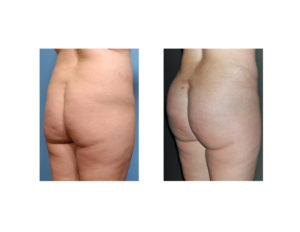Enhancing the Shape and Size of the Buttocks with Butt Implants (Gluteoplasty)

Buttock implants or gluteal implants are semisolid, rubbery silicone implants that have several basic shapes and sizes for the buttock area. They are not liquid filled nor should any surgeon ever use those type of implants for anything other than the breast. The buttock implants are fairly soft and flexible and don’t feel that much different from dense buttock tissue. The main plastic surgery issue with buttock implants is the surgical technique by which they placed. This has been controversial over the years. Should the buttock implant go into the gluteal muscles (intramuscular) or on top of them? (subfascial) While some controversy probably still exists, I think the best technique is intramuscular where the implant is completely surrounded by well vascularized muscle. The only downside to this technique is that the size of the implant is limited to about 300cc to 350cc in even the largest patients.
Through a midline incision in the upper buttocks crease, a pocket is carefully developed in the gluteus maximus muscle. The pocket is developed with an instrument staying within carefully determined markings done prior to surgery with the patient standing. The size and shape of the buttock implant (round or oval) is determined prior to surgery during the initial consultation based on the size and shape of the buttocks and what area of the buttock needs to be increased in size the most. The buttock implant is then slipped into this carefully made pocket. No type of compression garments is needed after surgery. Walking and sitting are allowed after 24 hrs. Sleeping should be done on the patient’s side for 1 week and driving is allowed after 7 days. Working out and running should not be resumed for at least one month after surgery.
I have found buttock implant surgery to be very gratifying for most patients, However, be aware that buttock implant surgery is painful and some sufficient recovery time is needed. The most common complication of buttock implant surgery is fluid collection (seroma) around the implant which may require drainage.
Dr Barry Eppley
Indianapolis,Indiana


